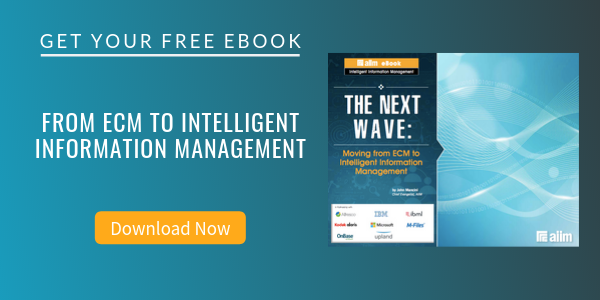
15 Great How-to Guides and Checklists to Help You Survive InfoChaos
Intelligent Information Management (IIM)
Information (documents, emails, videos, podcasts, voicemails, texts, tweets, Facebook posts, LinkedIn conversations, customer analytics, etc.) surrounds us. We rely on this information for entertainment and to do our jobs. Access by employees to information and manipulation by companies of their customer information to serve customer needs is THE competitive advantage today.
Better information equals better results.
The problem? That information is everywhere and not always managed effectively. By managed we mean channeled towards some business outcome. We use the phrase “Information Chaos” to describe this ongoing and accelerating state of massive information disruption.
Take back control and tame your Information Chaos with this round-up of the best free content on Intelligent Information Management. Enjoy!
.jpg?width=201&name=iStock_000011860969Small--question_(4).jpg)
1. Build an Effective Social Business Strategy in 8 Steps
Can you share information without compromising security or control? All it takes is one rogue Twitter or Facebook post to deliver a significant blow to your brand image. While you can’t be cavalier about who says what in your organization’s name, neither can you lock down access to social media outlets. So what's the solution? Establish a social media policy to proactively guide your employees on leveraging social business while protecting your organization.
2. Prepare Your Organization for Change
How well your employees adapt to and adopt a new technology initiative will determine how to affect the plan contributes to boosting your company's productivity and bottom line. Learn how to accurately and effectively manage your organization’s content and adapt to change with an enterprise content management strategy.
3. Get Records Management Governance Right in 12 Steps
In order to improve governance and minimize risk to your organization, you must have 100% adoption of records management policies from top-level management to line of business employees. Everyone must play a part! Learn how to avoid unfortunate and costly non-compliance issues with this NEW ERM best practices checklist.
4. Control Your Information Domain with Governance in SharePoint
A successful implementation of SharePoint for Enterprise Content Management (ECM) requires a strategy and structure for how to share and manage information. Governance, as it relates to information management, addresses how information is created and managed in the enterprise. Most organizations have some form of information governance in place; the question is how well can it be applied to your SharePoint environment.
5. Design a Successful Taxonomy in 9 Steps
To remove inefficiencies with your business information, you need to first have a process for identifying and then a plan for eliminating those gaps. Read this new checklist and learn how to successfully develop taxonomies with your organizations content.
6. Improve Co-Authoring and Collaboration in SharePoint
Organizations will succeed only when you encourage a collaborative environment in all aspects of information management. Learn ways to simplify business intelligence, content management, search, and sharing in this FREE checklist.
7. Make Better Business Decisions With Capture
Companies run on information. Your customers' information enters your company from paper documents, email, fax, mobile, Web, social, and MFPs. Capture is no longer a take paper, insert in scanner, create document image process. Capture tools can now ingest data from multiple streams and covert into meaningful insight that can improve your business.
8. Pave the Right BPM Cowpath
If your organization is like most, you've got bottlenecks in how your organization captures, accesses, and manages core business information. Get this checklist and learn how to streamline and re-engineer your processes with some powerful research results.
9. Achieve Records Management Best Practices
Organizations need to take a holistic approach to manage their records and information. Policies and processes must address information across the whole enterprise. As email and instant messaging have come into extensive use, we have seen additional policies to support their usage. In the past few years, as social business has become very popular in organizations, we see policies that cover social media that may very well address the use of Facebook, LinkedIn, Twitter, and other social media applications.
10. Conduct a Social Business Assessment
Effective management of business processes requires a periodic assessment to determine whether goals and objectives are being met and to take corrective actions where they are not. At the same time, one of the challenges organizations face as they implement social business processes and technologies is determining where to start. In both instances, it makes sense to conduct some sort of formal, rigorous assessment to understand where the organization is for particular processes and how to improve them.
11. Unclog Your Business by Automating Content-Intensive Process
Most business processes happen through serendipitous need. Action is needed, someone does something that works, and the organization accepts this as the way things should be done going forward. As such, many organizations do not fully understand how things happen, nor have they considered alternative ways to improve their processes, especially in relation to their content and how it moves through the organization. In order to truly understand organizational processes and the impact they have with content or content with the process, you need to map the process and document the interaction with content.
12. Assess Scanning and Capture Requirements
From the beginning of time, there has been a need to capture information for various reasons. We use the captured information to communicate, and share ideas and history with others, evolving from hieroglyphics to modern-day content in both paper and digitally-born form. To manage the capture of paper-based information, imaging is the tool used to scan and connect the paper world of the past with the present. All of this effort in capturing and managing information revolves around the desire to organize and find those bits of information deemed to have business value.
13. Automate ERM with SharePoint
Back in the era of SharePoint 2007, few people thought we’d be discussing records management with SharePoint 2010, let alone automating records management with it. Yet here we are with this very real possibility and two ways that we can achieve it. In this paper, we start by answering the question that is begged of ERM automation in SharePoint that most start with, namely, “is that even possible?” The short answer is... Yes. The long answer is, it must be planned and isn’t easy to establish, you need a good amount of knowledge up-front, but an organization that plans will be served very well.
14. Support Collaboration and Social Business with ECM
Often, Enterprise Content Management (ECM) projects are mandated from above to address a business problem that has emerged or a perceived benefit that will be gained as a result of implementing ECM. At other times, ECM is a strategic directive focused on moving an organization in a new direction based on the vision of what the organization could be like in the future. This is where we will often hear references to the use of ECM technologies in support of collaboration and social business initiatives. Organizations want to strengthen collaborative capabilities internally and expand interactions with clients through the use of social media tools. In either case, you will need to identify the organizational vision and goals and current state problems in achieving those goals.
15. Use SharePoint as a Self-Help Knowledge Center
People have different styles of learning. The challenge of any new system and SharePoint is no exception, is getting people comfortable enough that they will return, use it, teach themselves, and encourage others. By having a self-supported system, with access to online training materials for the basics, support/helpdesk calls are largely reduced. The other challenge is inspiring people to share what they learn with others and to document as they go. As with any acquired skill; we all forget very quickly how hard it was to begin, and how easy it became with time. Tools like wikis and FAQ forums all assist in capturing and sharing the knowledge from the whole team.
About John Mancini
John Mancini is the President of Content Results, LLC and the Past President of AIIM. He is a well-known author, speaker, and advisor on information management, digital transformation and intelligent automation. John is a frequent keynote speaker and author of more than 30 eBooks on a variety of topics. He can be found on Twitter, LinkedIn and Facebook as jmancini77. Recent keynote topics include: The Stairway to Digital Transformation Navigating Disruptive Waters — 4 Things You Need to Know to Build Your Digital Transformation Strategy Getting Ahead of the Digital Transformation Curve Viewing Information Management Through a New Lens Digital Disruption: 6 Strategies to Avoid Being “Blockbustered” Specialties: Keynote speaker and writer on AI, RPA, intelligent Information Management, Intelligent Automation and Digital Transformation. Consensus-building with Boards to create strategic focus, action, and accountability. Extensive public speaking and public relations work Conversant and experienced in major technology issues and trends. Expert on inbound and content marketing, particularly in an association environment and on the Hubspot platform. John is a Phi Beta Kappa graduate of the College of William and Mary, and holds an M.A. in Public Policy from the Woodrow Wilson School at Princeton University.


